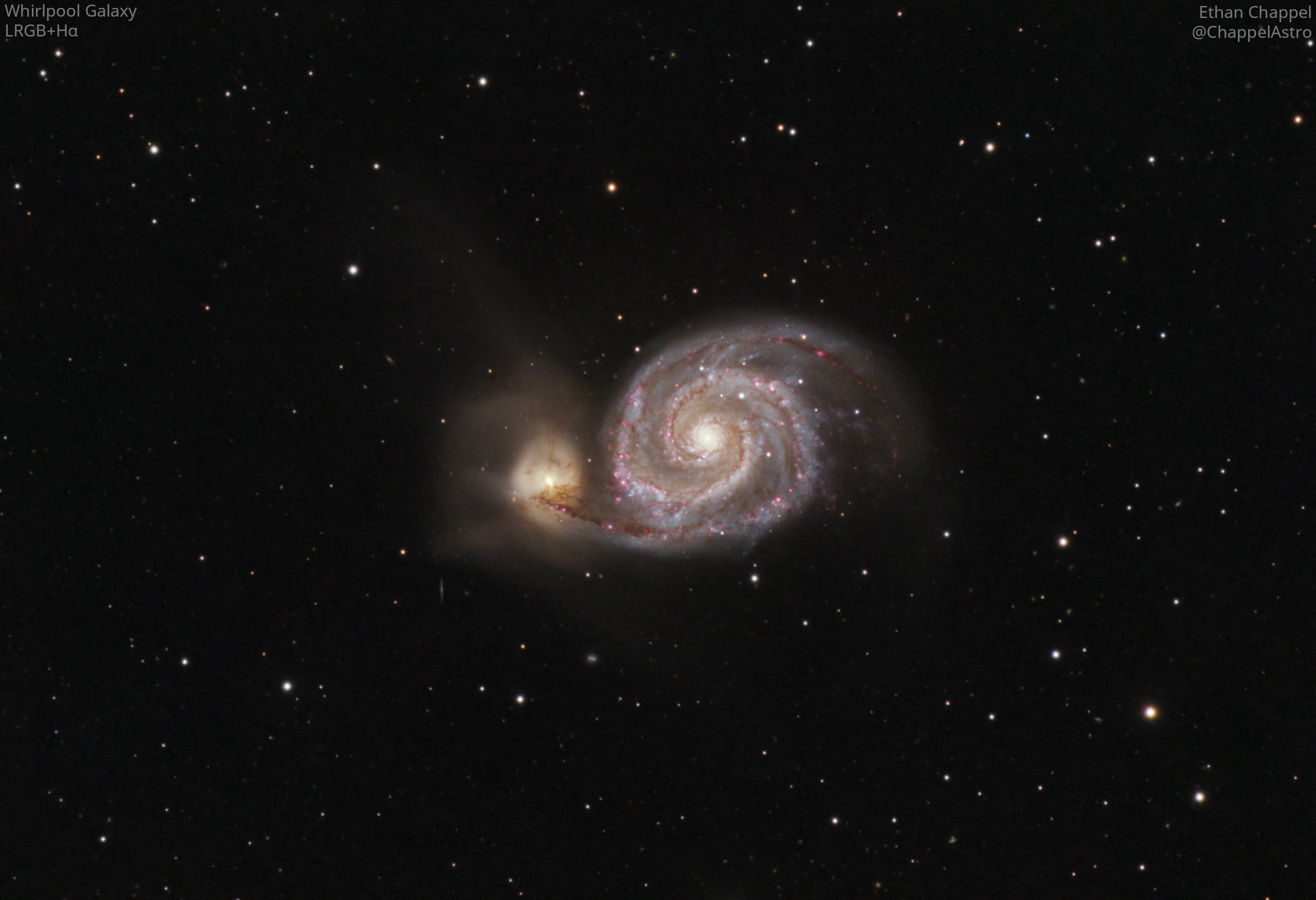
First Image at F/10: Whirlpool Galaxy
Description
Much has happened to my long focal length deep-sky imaging setup since the Fish Nebula image taken at the Eldorado Star Party. After plenty of experimentation and research, I decided it was best to remove the 0.7x reducer since the field of view was not sufficiently flat and stars near the corners had a noticeable amount of lateral chromatic aberration. I also resolved periodic jumps that had developed in the mount's right ascension axis by replacing the belt pulley for the right ascension axis. With those issues out of the way, I was ready to grind away at deep-sky targets from the comfort of my light-polluted backyard.
I decided the first target with the revamped setup would be a well-known one to help me understand what is possible in my circumstance. Given its convenient position in the sky and status as my favorite deep-sky object, the obvious target was the Whirlpool Galaxy and its neighbor, NGC 5195. These galaxies can be found in the constellation of Canes Venatici, not far from the bright star Alkaid in neighboring Ursa Major. It's distance of 31 million light-years makes it relatively close by galactic standards, giving us a nice view of the face-on spiral galaxy. The encounter with NGC 5195 enhanced the spiral structure of the Whirlpool galaxy and triggered intense star formation as evidenced by the numerous pink Hydrogen II regions and short-lived blue stars in the arms.
This image includes about 41 hours of LRGB data from my backyard, which typically has a background magnitude of 18.5 per square arc-second according to my sky quality meter. If captured at a perfect dark sky site (22.0), I would theoretically need just 1.6 hours of sub-exposures for a similar signal-to-noise ratio. If the 41 hours were captured at the perfect dark sky site, I would needed 1027 hours (43.8 days) of sub-exposures from my backyard to match.
Celestron EdgeHD 8, Sky-Watcher EQ6-R Pro, QHY 268M-PH, CFW3-US, OAG-M, ZWO ASI174MM Mini, Astrodon 36mm unmounted LRGB + 5nm Ha, Rigel Systems Stepper Motor, Pegasus Astro Ultimate Powerbox v2, Falcon Rotator, Spike-a Flat Fielder Standard, Intel NUC8i3BEK
N.I.N.A + Hocus Focus, PHD2 Guiding, PixInsight + Normalize Scale Gradient, Photoshop CC
Luminance
2022-01-21: 225x60s (3.75h)
2022-01-28: 171x60s (2.85h)
2022-01-29: 80x60s (1.33h)
2022-02-04: 238x60s (3.97h)
2022-02-05: 267x60s (4.45h)
Total: 981x60s (16.35h)
Red
2022-02-07: 70x180s (3.50h)
2022-02-08: 87x180s (4.45h)
Total: 157x180s (7.85h)
Green
2022-02-09: 25x180s (1.25h)
2022-02-10: 88x180s (4.40h)
2022-02-11: 67x180s (3.35h)
Total: 180x180s (9.00h)
Blue
2022-02-27: 161x180s (8.05h)
2022-03-09: 59x180s (2.95h)
2022-03-12: 33x180s (1.65h)
Total: 161x180s (8.05h)
Hydrogen-Alpha
2022-02-12: 38x300s (3.17h)
2022-02-13: 42x300s (3.50h)
2022-02-14: 43x300s (3.58h)
2022-02-18: 17x300s (1.42h)
Total: 140x300s (11.67h)
Integration: 52.92h
Licensed under Creative Commons Attribution 4.0 International (CC BY 4.0)